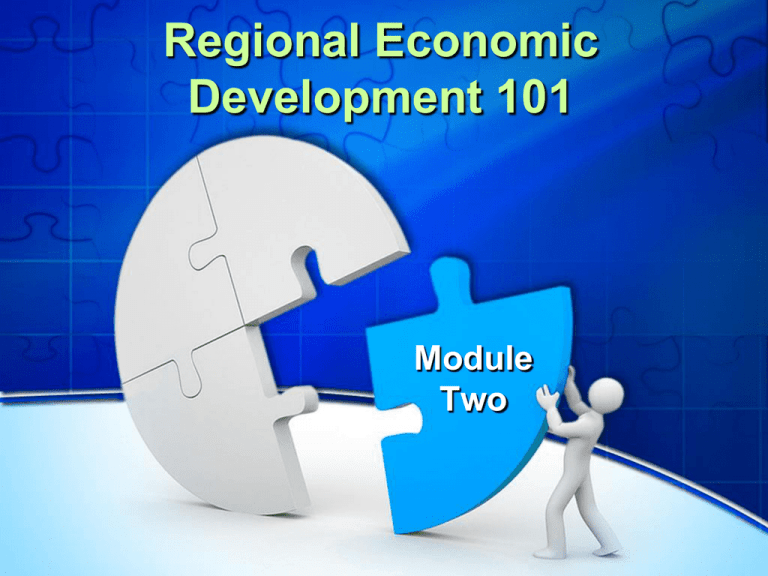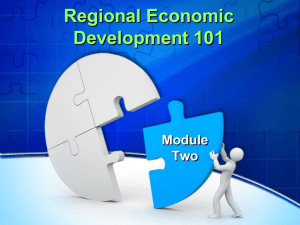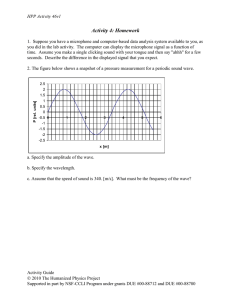Module Two – PowerPoint Presentation
advertisement

Regional Economic Development 101 Module Two Session Overview • It’s a Changing World: Some Major Trends • Implications of These Trends • Local and Regional Economic Development Defining key terms Three waves of economic development Economic development approaches • A Look at Regional Development A new game plan and key principles • What Should Your Region Do? It’s a Changing World Out There: Major Trends Mega-Trends: Global Economy Growth of service industry Specialization of regions and communities Expanded importance of creative and knowledge Expanded growth of economies entrepreneurs and the self-employed Polarization of work reflecting knowledge, skills Connections between and abilities places having complementary Outsourcing that divides specializations or “value-chain” functions resources into more productive, interdependent activities Mega-Trends: Economic Development Ongoing emphasis on job creation as the key goal Continued focus on companies rather than industries or people Loss of private sector leadership due to declining presence of corporate headquarters and branch plants Need for talented workforce to be competitive Greater scrutiny of public economic development investments (i.e., business incentives) Need for economic developers with new skills: • Better market intelligence • Ability to link fragmented networks of participants • Capacity to showcase community or regional “product” GROUP ACTIVITY: REGIONAL TRENDS With A Partner… • Select a trend that you believe is impacting this region. • Discuss with your partner the impact of this trend and why it’s important. • Be ready to share with your entire SET team. General Implications of These Trends? • • • • • Innovation is critical Regionalism matters Process matters Efforts must consider both regional assets and obstacles Success requires capacity, buy-in and legitimacy Implications of These Trends (continued) • Mindsets (of economic developers, local leaders, citizens) must be aligned to the new realities. • Economic development and workforce development must be linked. • Collaboration is important to the design and implementation of economic development strategies. Examining Your Local & Regional Economic Development Activities: Do They Align with the Trends? Defining Economic Development: Group Discussion • How do you define economic development? • What do you view as an “economic development success”? Defining Economic Development • Efforts to expand the economic capacity of a local area in order to improve its economic future and the quality of life for all. • A process by which public, business, and non-governmental sector partners work collectively to create better conditions for economic growth, employment generation and wealth creation. Defining Regional Economic Development “A combination of qualitative and quantitative features of a region’s economy . . . [It] includes the types of jobs – not only their number – and long-term structural characteristics, such as the ability to bring about new economic activity and the capacity to maximize the benefits which remains within the region.” -- Ed Malecki Three Waves of Economic Development Component First Wave Second Wave Goal Industrial Recruiting: Attract outside businesses Cost Competition: Retain and expand existing businesses Regional Competitiveness: Enhance regional resources to promote regional collaboration and clusters Strategies Provision of financial incentives • Reduction of taxes • Deregulation • Industry consolidation and cost cutting (i.e., lean manufacturing) • Entrepreneurship • Regional collaboration • Identification and development of regional clusters and import substitution activities • Develop training programs • Strengthen the health of existing firms • Provide social and physical resources • Build on unique regional assets (such as human capital, amenities, creative economy; innovation) • Focus on leadership development • Develop/maintain quality environment • Bridge economic and community development Building of industrial parks Keys to Success Offer government funds for subsidies and tax breaks Develop an industrial infrastructure Third Wave Source: Blakely & Ted Bradshaw (2002); Drabenstott (2006); Hembd (2008) Economic Development Approaches: Which Ones Are You Pursuing? • Industrial recruitment & attraction • Business retention & expansion • Small business development • Entrepreneurship/business incubators • Micro-enterprise development • Downtown revitalization • Workforce development and training • Economic gardening • Economic/occupational clusters • Information technology infrastructure • Building on local assets (tourism, recreation, physical and/or cultural amenities) • Attracting creative and educated people • Value-added agriculture enterprises • Others? Your Current Economic Development Strategies Current Strategies (List below) To Which Wave Does it Relate? Let’s Look at Regional Development What Is a Region? • Geographical area of similar characteristics Similar within Different between (different from other places) • Place of interest to people, with a unique identity and meaning Types of Regions • • • • • • Functional Regions Economic Regions Political Regions Administrative Regions Data Regions “Issue” Regions Each of these regions is valid. Which one you use simply depends on what you are attempting to do. A Caution on Determining Your Region • A given county or place may be part of multiple relevant economic development “regions” • Some regions will only be used for data analysis and comparison factors • A single definitive region seldom exists for any locality The appropriate region will depend on current strategies and concerns Defining Your Region Start With What Makes Sense • Sometimes neighboring counties don’t have anything in common • Look beyond traditional boundaries: State Lines County Lines Rural/Metro Lines • Find areas that share interests and goals Why a Regional Approach? • Helps local governments to view their communities as part of an integrated economic area • Joins the assets – intellectual, financial, institutional, logistical, and physical – of cities, towns, and counties/parishes. Taken together, these resources are vital to spurring economic activity Sources: Cheryl A. Burkhart-Kriesel (2002) and Sara Lawrence (2001) Why a Regional Approach? (continued) It Promotes the Three Cs: Conversation: Helps promote discussions among public & private sector leaders and local residents; builds regional awareness; focuses on consensus building; focuses on the future Connection: Regionalism is a contact sport that requires personal interactions at every stage of the game Capacity: Helps leverage key assets; it weaves the system of support needed to create and attract businesses Source: Council on Competitiveness (2010) Regional Economic Development: A New Game Plan Three major components of the plan: • Encourage regional critical mass – act regionally to compete globally • Prioritize investments in public goods and services to unlock a region’s economic potential • Spur innovation to transform a region’s economy Source: Mark Drabenstott (2010) Seven Policy Principles to Consider Implementing 1. Seize regional competitive advantage 2. Invest in transportation & telecommunications infrastructure 3. Adopt technologies that strengthen competitive advantage 4. Strengthen rural labor markets and boost worker skills 5. Foster better collaboration across jurisdictional lines in rural regions 6. Restructure agriculture by increasing value-added business activities 7. Improve the delivery of public services in rural areas Based on 20 case studies around the world. Reported in Drabenstott (2010) Successful Regions Have… • Leaders that recognize the new realities of economic development • Regional ties • A global view • An understanding of current strengths and weaknesses • Flexibility and adaptability Successful Regions Have…. • The capacity to respond • A comprehensive view of development • A mechanism for continuously searching for opportunities • A way to evaluate impact Group Discussion • What has been the regional economic development planning history in this region? • Are there regional plans? Who developed them? Are they widely known and used? With A Partner… Reflect on the region’s planning history: What have been some successes? What may be future challenges? How well do your efforts align with the following: • The “Third Wave”? • The New Game Plan? • The Seven Principles? Final Reflections • What are the takeaways from this module? • What items did you find most helpful? Least helpful? • What needs to be done before the next SET meeting to build on this topic? • Other people who need to be invited to the next SET session? If so, who will contact? • Other items you want to mention? Looking Ahead . . . 3 • Building a Strong Regional Team 4 • Developing a Vision and Goals for the Region 5 • Exploring Regional Assets and Barriers 6 • Current Demographic Features of Your Region 7 • The Region’s Economic Foundation & Opportunities 8 • Planning for Success 9 • Measuring for Success





